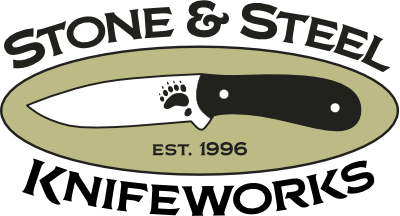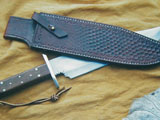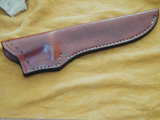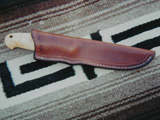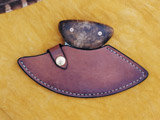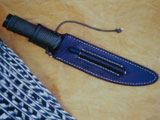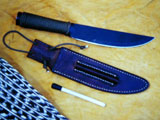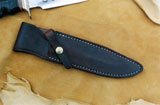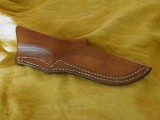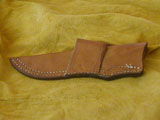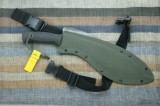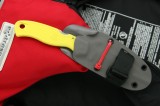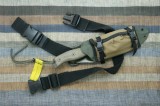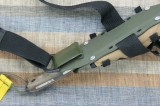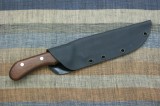Leather
Here are some examples of leather sheaths I have made. All my sheaths are constructed of vegetable tanned 8-9 oz cow hide I purchase from a local tannery, saddle-stitched by hand with 5 and 7 cord linen thread and treated with a warm beeswax and neatsfoot oil formula.
For more details on how I make a leather sheaths, read my leather sheathmaking tutorial.
(to see a larger image, click on the picture)
Thermoplastic
I was slow to embrace thermoplastic as a sheath material. Commonly referred to by the trade name Kydex, this material had all the appeal to me of, well, plastic. But after I tried it on a knife I carried for almost three years in the field I found it did have some very tolerable values. It is fairly easy to work with, is almost indestructible and generally makes a very secure/safe sheath.
The other nice thing about it is that positive retention can be easily built into a sheath eliminating the need for any keeper straps.
I now feel it is the perfect sheath material for tools or situations that include a lot of moisture or rough use. It just takes a beating and keeps going. It is kind of the micarta of sheath materials.
The one downside, since it is rather hard, is it often can facilitate scratches in the blade of a knife. The plastic often rubs against the blade, at least somewhere. So any dust or grit that gets trapped between the sheath material and the knife will abrade both to some extent. For this reason I recommend thermoplastic sheaths only for working tools, ones you don’t mind a few scratches on anyway. I will say that I have seen thermoplastic sheaths lined with leather or nylon fabric to cushion the contact with the knife, but I have not tried it myself.
Here are some examples of sheaths I have made using Kydex. All of my sheaths are constructed from 0.08 Kydex with ¼” rivets.
Check out my tutorial on constructing a Kydex Sheath.
(to see a larger image, click on the picture)
